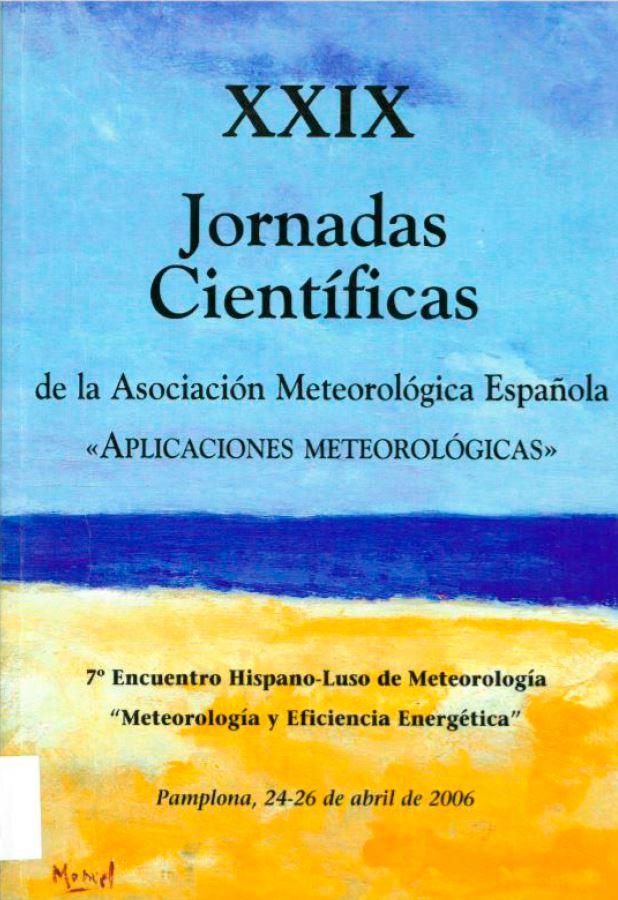MODELOS CLIMÁTICOS Y TENDENCIAS DE PRECIPITACIÓN
Resumen
Entre los objetivos de los estudios sobre el cambio climático se encuentran aquellos que tratan de identificar tendencias y otras señales de variabilidad utilizando modelos climáticos. Una de las dificultades en relación a la interpretación de las tendencias se debe a las desviaciones y errores entre los datos simulados respecto a los observados. Por ello nos hemos planteado el estudio sobre la adecuación de un conjunto de modelos climáticos globales para representar el comportamiento de la precipitación de invierno en la Península Ibérica. Para efectuar este trabajo sobre las discrepancias entre modelos y observaciones hemos seleccionado modelos con distintas características y que forman parte del 4º informe del Panel Intergubernamental sobre el cambio climático (IPCC). En este caso nos centramos en la validación del comportamiento espacial promediando la evolución temporal de invierno, así como en la comparación de las tendencias de la serie temporal de invierno obtenida a partir del promedio arealar para datos observados y simulados.Citas
Collins W.D., C.M. Bitz, M.L. Blackmon, G.B. Bonan, C.S. Bretherton, J.A. Carton, P. Chang, S.C. Doney, J.J. Hack, T.B. Henderson, J.T. Kiehl, W.G. Large, D.S. McKenna, B.D. Santer, and R.D. Smith, 2005: The Community Climate System Model: CCSM3. (Submitted to J. Climate)
Dai A., W.M. Washington, G.A. Meehl, T.W. Bettge and W.G. Strand, 2004: The ACPI climate change simulations. Climatic Change, 62, 29-43. Delworth T.L., R.J. Stouffer, K.W. Dixon, M.J. Spelman, T.R. Knutson, A.J. Broccoli, P.J. Kushner and R.T. Wetherald, 2002: Review of simulations of climate variability and change with the GFDL R30 coupled climate model. Climate Dyn. 19, 555-574. Déqué M., C. Dreveton, A. Braun, and D. Cariolle, 1994: The ARPEGE/IFS atmosphere model: A contribution to the French community climate modelling. Climate Dyn. 10, 249-266. Dixon K.W., T.L. Delworth, T.R. Knutson, M.J. Spelman and R.J. Stouffer, 2003: A comparison of climate change simulations produced by two GFDL coupled climate models. Glob. Planet. Change. 37, 81-102. Flato G.M., G.J. Boer, W.G. Lee, N.A. McFarlane, D. Ramsden, M.C. Reader and A.J. Weaver, 2000: The Canadian Centre for Climate Modelling and Analysis Global Coupled Model and its Climate. Climate Dyn. 16, 451-467. Gordon H.B., L.D. Rotstayn, J.L. McGregor, M.R. Dix, E.A. Kowalczyk, S.P. O'Farrell, L.J. Waterman, A.C. Hirst, S.G. Wilson, M.A. Collier, I.G. Watterson, and T.I. Elliott, 2002: The CSIRO Mk3 Climate System Model [Electronic publication]. Aspendale: CSIRO Atmospheric Research. (CSIRO Atmospheric Research technical paper; no. 60). Kalnay E., M. Kanamitsu, R. Kistler, W. Collins, D. Deaven, L. Gandin, M. Iredell, S. Saha, G. White, J. Woollen, Y. Zhu, M. Chelliah, W. Ebisuzaki, W. Higgins, J. Janowiak, K. Mo, C. Ropelewski, J. Wang, A. Leetmaa, R. Reynolds, R. Jenne and D. Joseph, 1996: The NCEP/NCAR 40-year Reanalysis Project. Bull. Amer. Meteor. Soc. 77, 437-471.
K-1 model developers, 2004: K -1 coupled model (MIROC) description. Technical Report 1, Center for Climate System Research, University of Tokyo. Knutson T.R. and S. Manabe, 1998: Model assessment of decadal variability and trends in the tropical Pacific ocean. J. Climate. 11, 2273-2296. Nieto S. and Rodríguez-Puebla, 2006. Comparison of precipitation from observed data and general circulation models over the Iberian peninsula. J. Climate (accepted) Roeckner E., G. Bäuml, L. Bonaventura, R. Brokopf, M. Esch, M. Giorgetta, S. Hagemann, I. Kirchner, L. Kornblueh, E. Manzini, A. Rhodin, U. Schlese, U. Schulzweida, and A. Tompkins, 2003: The atmospheric general circulation model ECHAM5. Part I: Model description. Max Planck Institute for Meteorology, Report 349. [available from MPI for Meteorology, Bundesstr. 53, 20146 Hamburg, Germany] The GFDL Global Atmospheric Model Development Team, 2004: The New GFDL Global Atmosphere and land model AM2-LM2: Evaluation with prescribed SST simulations. J. Climate 17, 46414673. Washington W.M., J.W. Weatherly, G.A. Meehl, A.J. Semtner, Jr., T.W. Bettge, A.P. Craig, W.G. Strand, Jr., J.M. Arblaster, V.B. Wayland, R. James, Y. Zhang, 2000: Parallel climate model (PCM) control and transient simulations. Climate Dyn. 16, 755-774. Yukimoto S. and A. Noda, A., 2002: http://wwwcger.nies.go.jp/publication/I054/I054-5.pdf, 37-44.

